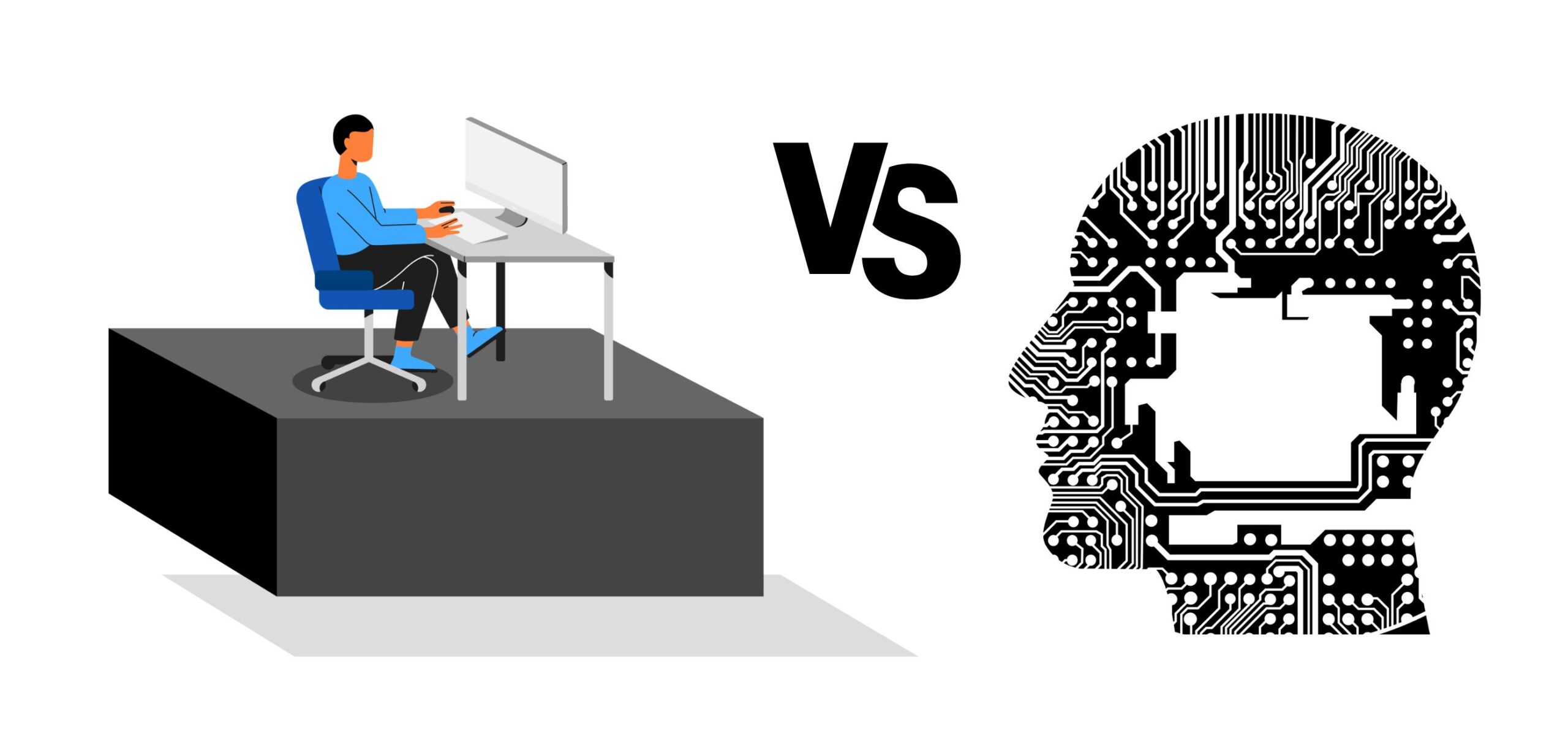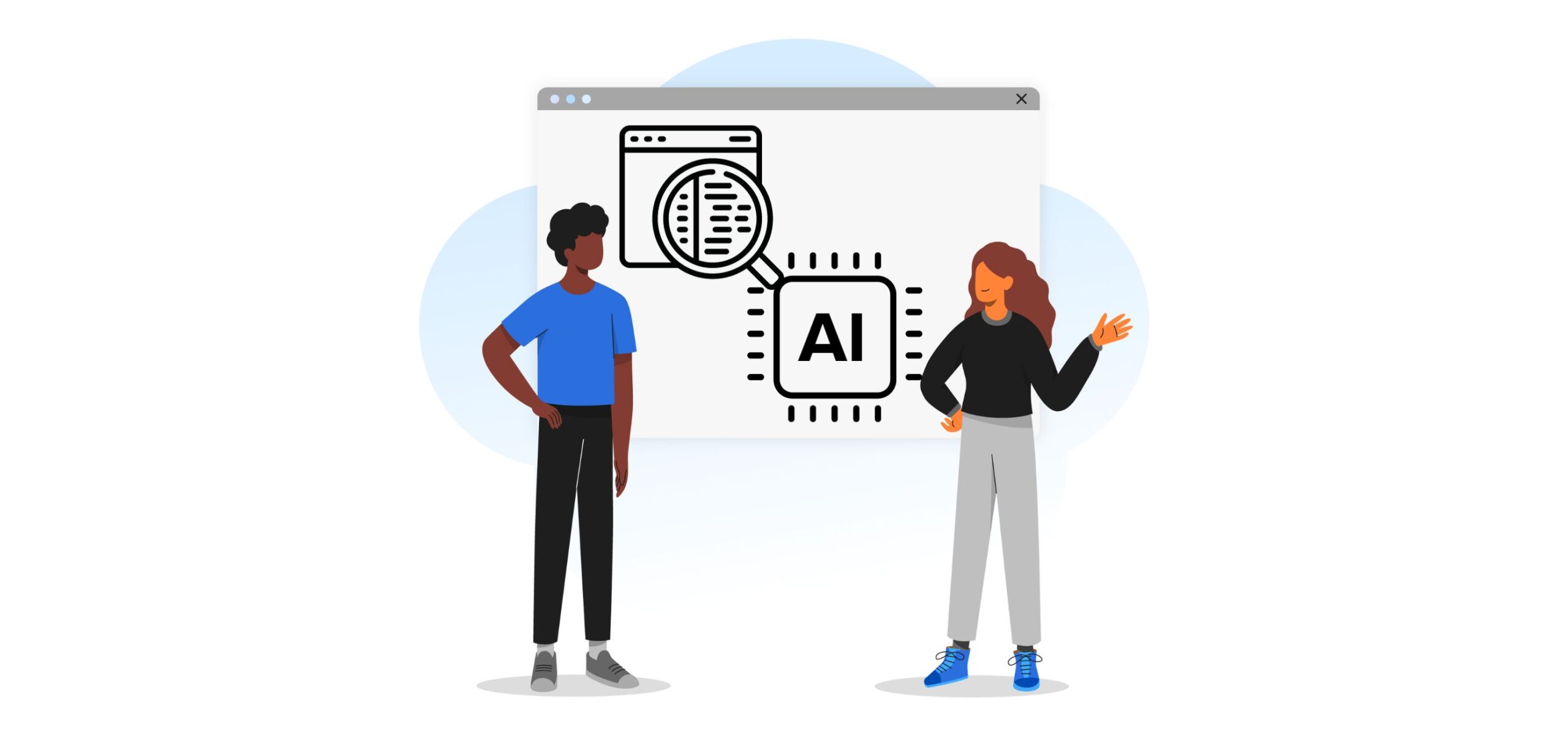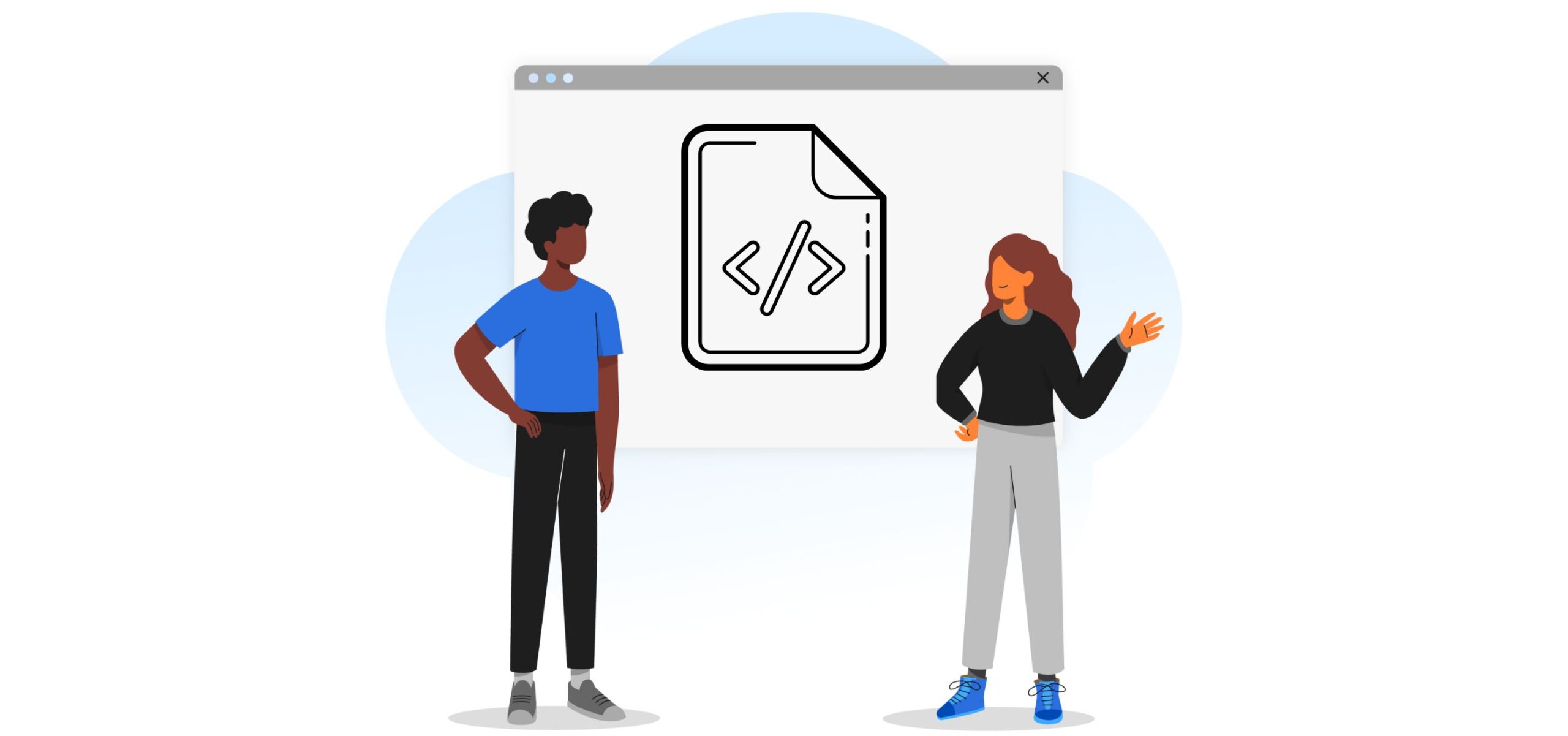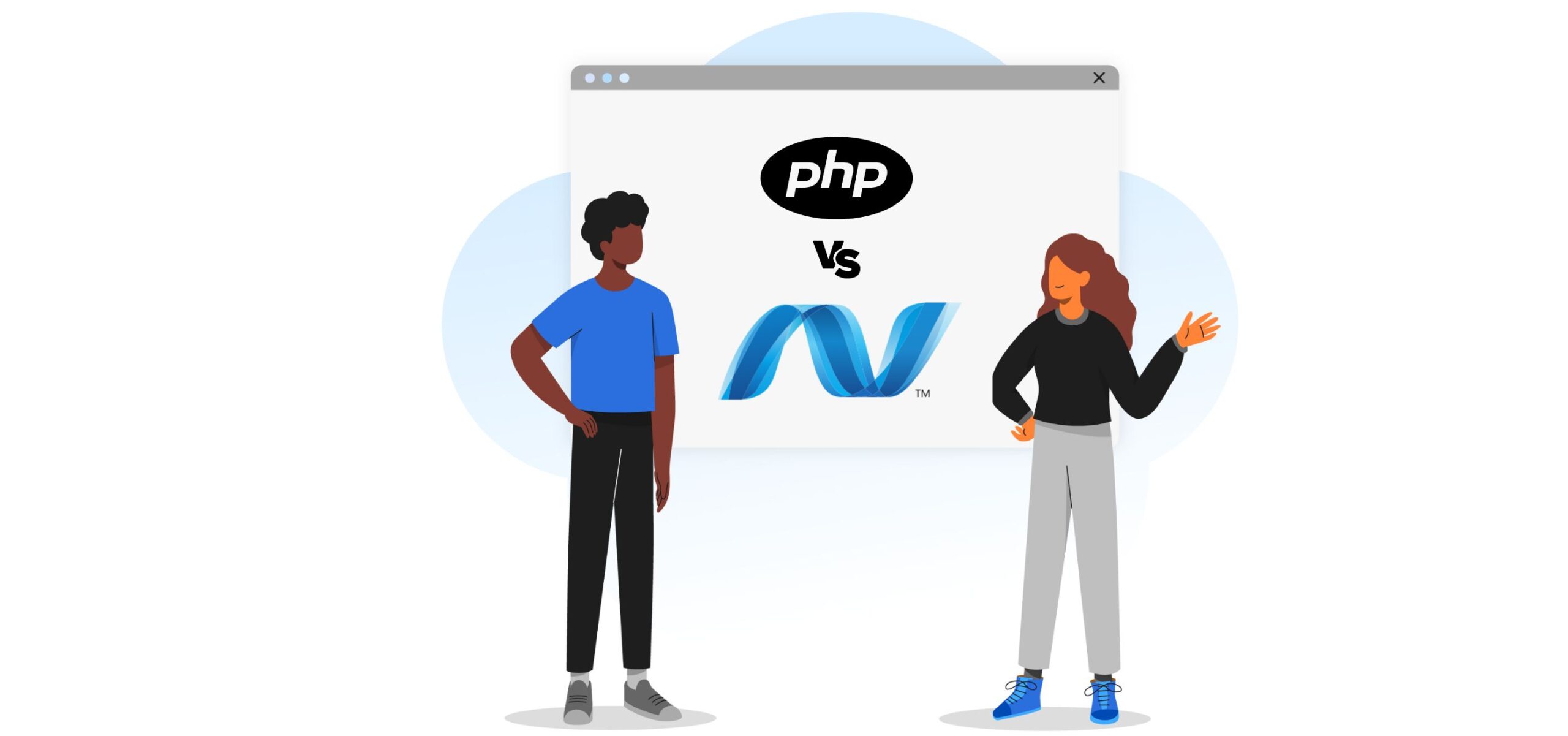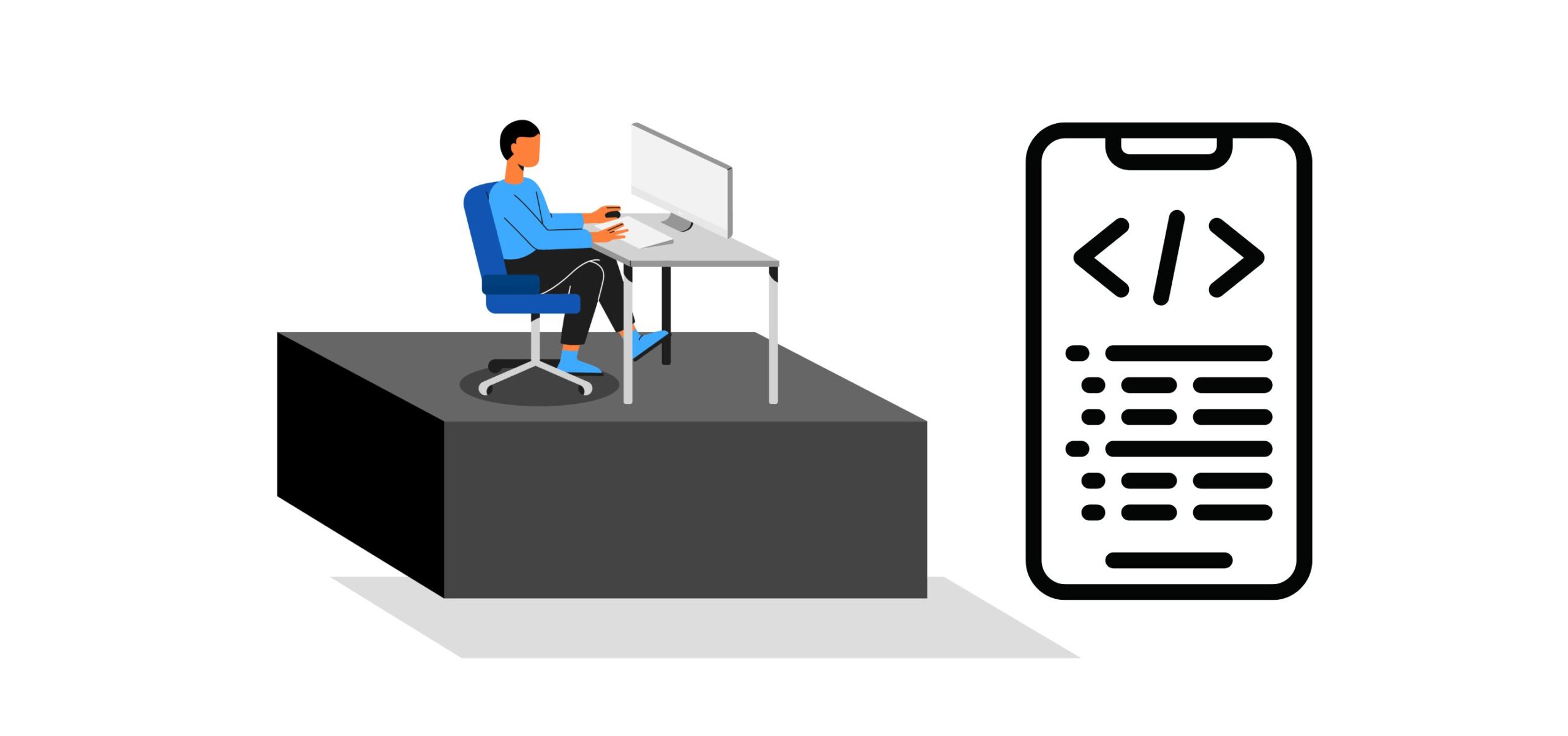ChatGPT vs Software Developers: Is Generative AI the End of the Road for Developers?
Generative AI has taken the world by storm. Yes, we’re talking about Open AI’s ChatGPT4. With tech giants like Google and Microsoft introducing Bard and AI-powered Bing, the AI space is only getting hotter! But what impact will AI have on software development and developer jobs? Most importantly, is AI going to replace software developers?
Every technology is aimed at improving the efficiency of its users. AI is no different. Using generative AI, software developers can increase their productivity, write better code, and meet high user expectations.
Generative AI can improve developers’ productivity by 10 folds!
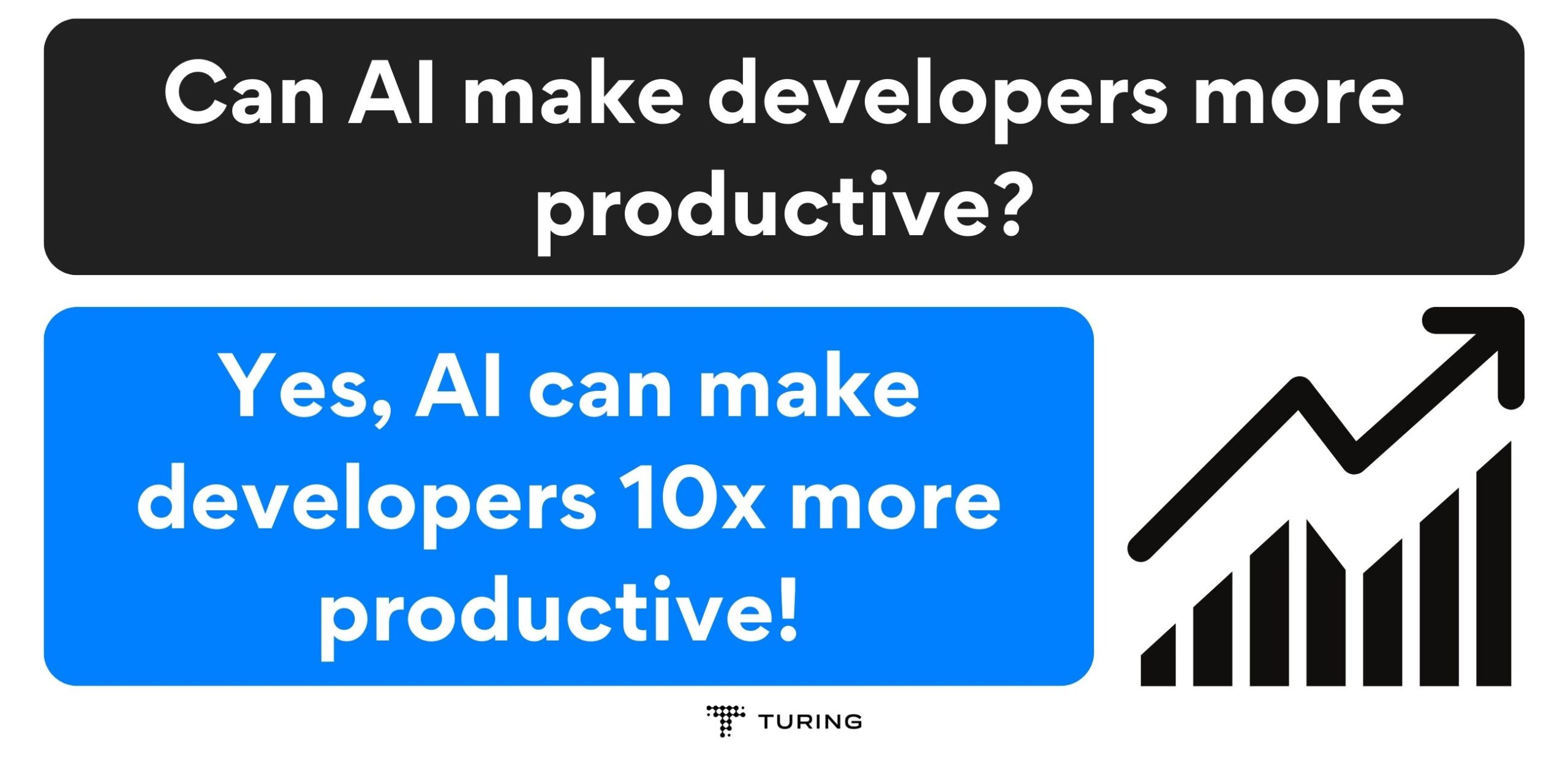
Can AI make developers more productive?
A prediction by Ark Invest states that AI can boost developers’ performance and increase their productivity by up to 10 folds! Jobs that require recurring coding can be automated with the help of AI. This can reduce the turnaround time for writing code from scratch, thus enhancing the productivity of software developers. Developers can utilize this time and create codes that require creative thinking that only a human mind is capable of. They can leverage AI to check for syntax errors, write clean code, debug code, and many more basic requirements.
As we know, resuing a code can accelerate the software development process. Developers can also use generative AI to enhance code reusability. Generative AI can find the section of the code that can be reused and can tailor it to meet the requirements of another software development process.
Generative AI and software development: Don’t fear AI
Marko Anastov, the co-founder of Semaphore CI/CD, states that generative AI tools such as ChatGPT have created fear amongst the developer community. He says that some developers are worried that AI will take their jobs, while others are completely ignoring it. Both approaches are wrong, according to Anastov. He says that developers should integrate AI into their workflow to increase their productivity. GitHub Copilot is a great example of this. The AI I pair programmer has proven beneficial in writing clean code faster. The GitHub Copilot is powered by OpenAI’s Codex, which is a generative language model.
Generative AI lacks what you have: Context!
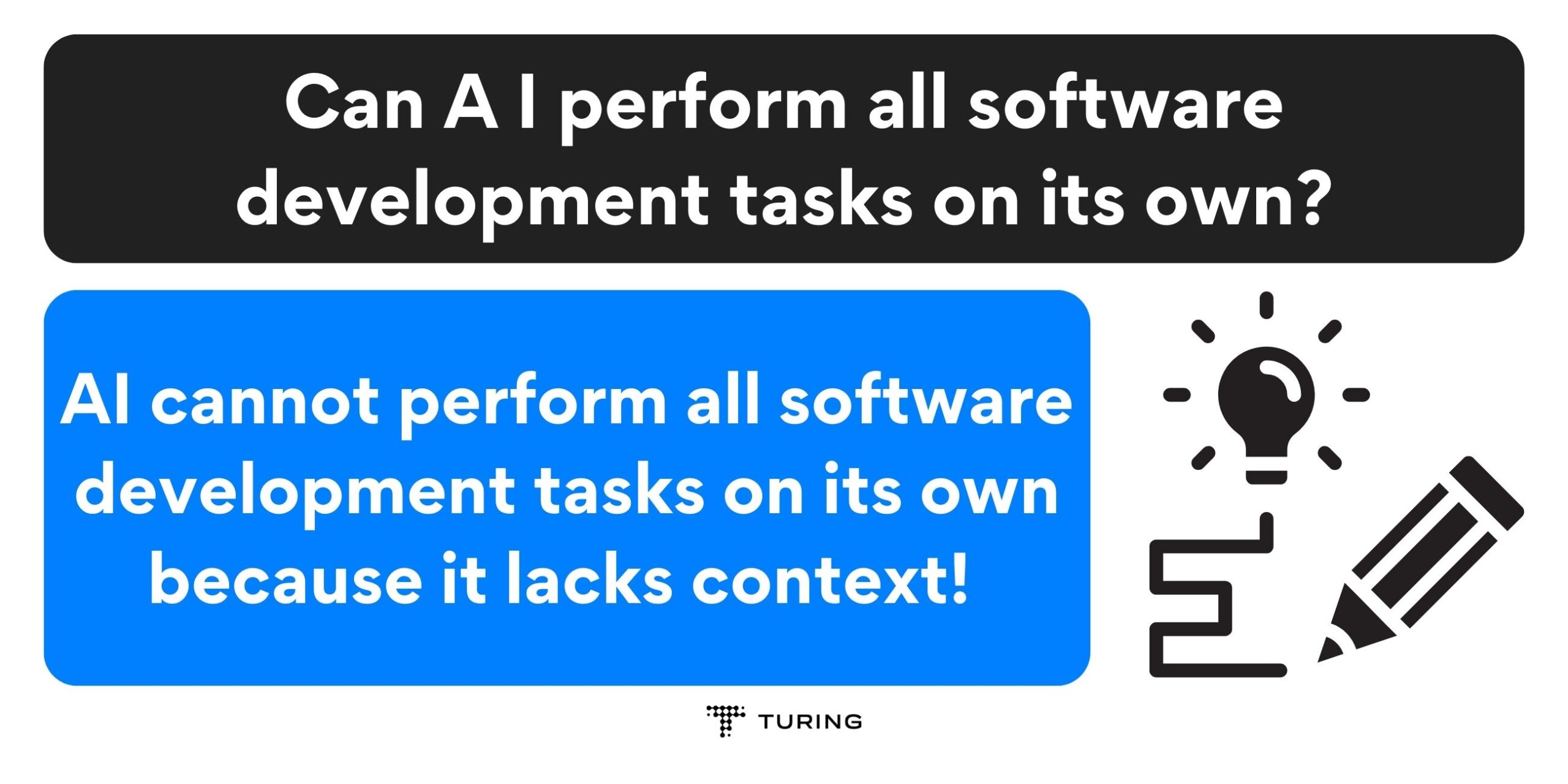
Generative AI lacks what you have: context!
Generative AI and software development can go hand-in-hand, but AI cannot completely perform the tasks on its own. Currently, AI is powered by the data that is fed to it, and not by any human intelligence. Generative AIs like ChatGPT lack the understanding of the human context of computing. Therefore, it requires software developers to add more details and create an appropriate experience through the software.
Where can software developers leverage AI?
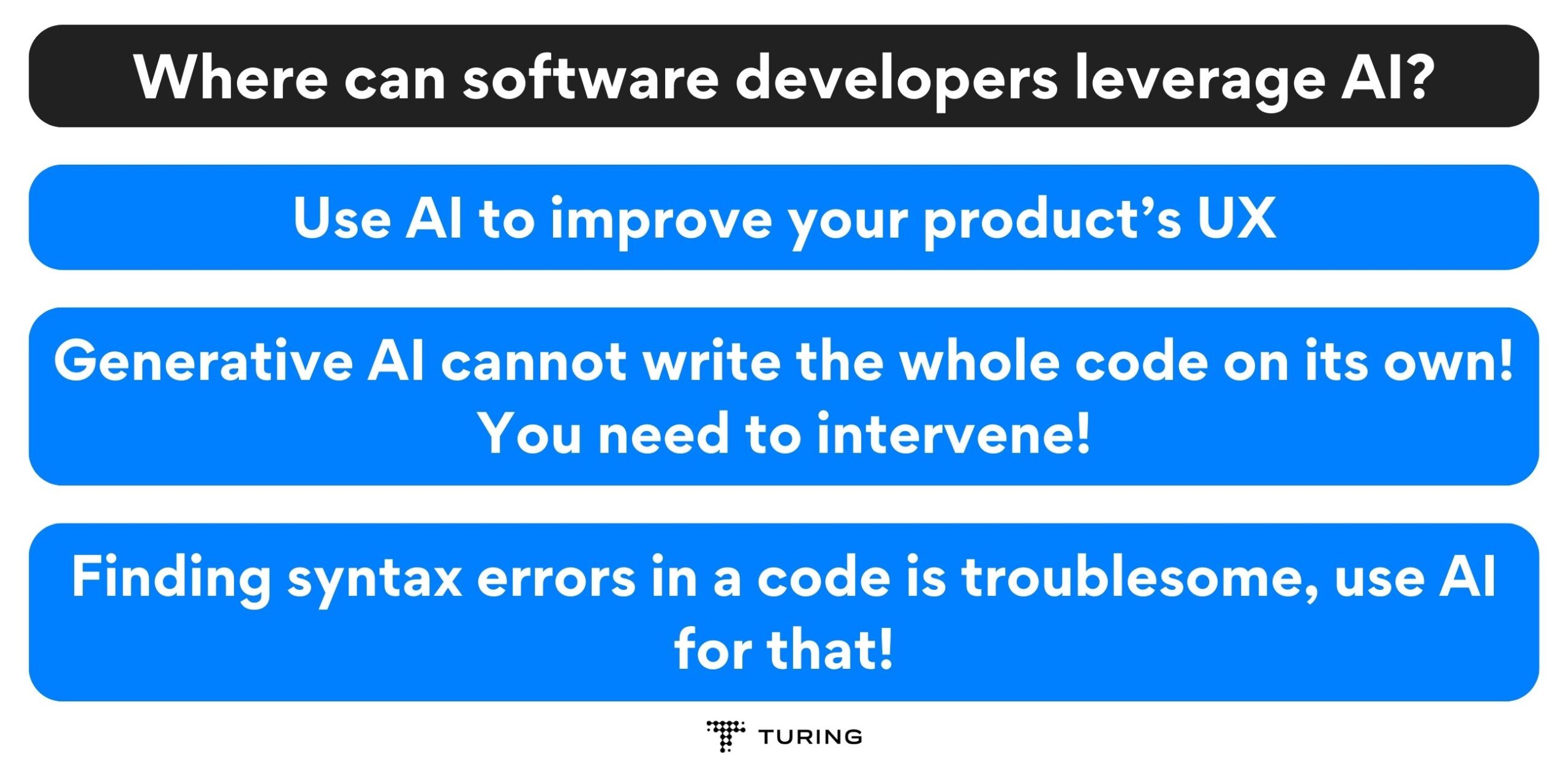
How to leverage AI as a software developer?
There’s so much you can do with generative AI to make the most of your software development career.
-
Use AI to improve your product’s UX
One thing that ChatGPT and other generative AI have and will keep on improving is the way they interact with the user. If you have a software application that requires interaction with the user using a search bar or something like that, you will have to upgrade it.
You can integrate generative AI into your software applications to improve the way you interact with your users. -
Generative AI cannot write the whole code on its own! You need to intervene!
While the AI is already writing codes and creating apps, it is simply scanning through the already provided database to do so. To create a breakthrough or to execute more sophisticated codes, software developers will have to intervene.
They can use AI to create basic code and enhance it according to the requirements using their own skills. If you’re a software developer reading this, this is the time to enhance your tech stack with AI development skills. -
Finding syntax errors in a code is troublesome, use AI for that!
So you have written a long code but it’s not working for some reason. Now, this could be because of a syntax error or something like that. But finding these small errors is a tough task. Let AI do it for you. Generative AI is capable of finding syntax errors in a code using machine learning techniques. Generative AI tools like DeepCode scans your code and recommend fixes for the syntax errors in your code thus improving your productivity.
What is GPT-4?
GPT-4, or Generative Pre-trained Transformer 4, is the next iteration of OpenAI’s language model following GPT-3. It builds upon the advancements and capabilities of its predecessor while introducing several notable improvements.
What programming languages does GPT-4 know?
As an AI language model, GPT-4 does not inherently “know” or comprehend programming languages like a human programmer. GPT-4 is trained on a vast amount of text data from the internet, which includes examples of code written in various programming languages. Therefore, it can generate text that resembles programming code or provide assistance with programming-related queries.
However, it’s important to note that GPT-4’s proficiency in generating code or assisting with programming tasks is limited to the patterns and examples it has learned during training. It does not possess practical programming knowledge, understanding of specific language syntax, or the ability to debug or execute code. For programming-related tasks, it’s recommended to consult dedicated programming resources and tools that are specifically designed for programming languages.
GPT-3 vs GPT-4: What are the major differences?
-
Enhanced Contextual Understanding:
GPT-4 demonstrates superior contextual understanding, resulting in more coherent and relevant responses compared to GPT-3. The training of GPT-4 on a broader and more diversified dataset allows it to grasp the complex context and provide more contextually suitable material. -
Increased Parameter Count:
GPT-4 surpasses GPT-3 in terms of parameter count, allowing for capturing finer nuances of language. The higher parameter count translates to more accurate and nuanced responses, giving the generated content a more natural and human-like feel. -
Specialization in Domains:
While GPT-3 excels in versatility across various domains, GPT-4 focuses on specialization in specific areas. GPT-4 undergoes fine-tuning for specific use cases, leading to improved performance and domain-specific expertise. -
Addressing Limitations:
GPT-4 addresses limitations observed in GPT-3, such as the occasional generation of incorrect or biased information. Stricter guidelines and quality control measures are implemented to mitigate these issues, ensuring more reliable and unbiased content generation. -
Improved Quality Control:
GPT-4 undergoes rigorous scrutiny and quality control measures to enhance the accuracy and reliability of generated content. OpenAI’s investment in refining the training process helps minimize potential errors and biases in the generated text. -
Progress in Naturalness and Coherence:
GPT-4 exhibits advancements in generating more natural and coherent responses compared to GPT-3. The improved contextual understanding and higher parameter count contribute to generating text that feels closer to human-generated content. -
Continued Learning from Human Input:
GPT-4 builds upon the success of GPT-3 by learning from vast amounts of human-generated content available on the internet. The ongoing learning process allows GPT-4 to continually refine its language generation capabilities. -
Potential for Specialized Applications:
GPT-4’s specialization in domains opens up possibilities for improved performance in specific areas, catering to diverse industry needs. Its increased capacity and expertise make it a promising tool for various applications, such as content generation, customer support, and more.
GPT 4: Use Cases
GPT-4, with its advanced language generation capabilities, finds utility in a wide range of real-world applications. Here are some notable use cases where GPT-4 can make a significant impact:
-
Content Generation and Copywriting:
GPT-4 can assist in generating high-quality content for articles, blog posts, social media captions, and marketing materials. It can aid copywriters by providing creative suggestions, refining drafts, and maintaining consistent brand tone and style. -
Customer Support and Chatbots:
GPT-4 can power chatbots and virtual assistants, offering more accurate and human-like interactions with customers. It can handle customer inquiries, provide product information, and offer personalized recommendations, improving customer satisfaction. -
Language Translation and Interpretation:
GPT-4’s language understanding and generation capabilities make it valuable for machine translation services. It can aid in translating text or even facilitate real-time interpretation during conversations or meetings. -
Personalized Recommendations:
GPT-4’s contextual understanding allows it to provide personalized recommendations in various domains, such as movies, books, music, or products. It can consider individual preferences, past behavior, and user feedback to suggest tailored options. -
Creative Writing and Storytelling:
GPT-4 can collaborate with writers, assisting in brainstorming ideas, developing characters, and creating engaging narratives. It can be a valuable tool for authors, screenwriters, and content creators looking for inspiration and story prompts. -
Academic and Technical Writing:
GPT-4 can aid students and researchers in generating academic papers, essays, and technical documentation. It can assist in organizing information, suggesting references, and providing language refinement. -
Virtual Simulation and Training:
GPT-4’s ability to generate realistic and contextually appropriate responses makes it suitable for virtual simulations and training scenarios. It can act as an interactive virtual character, providing real-time feedback, guidance, and simulations of different situations. -
Content Moderation:
GPT-4 can help in automating content moderation tasks by identifying and flagging potentially inappropriate or harmful content. It can assist in reducing the workload of human moderators and improving the efficiency of moderation processes.
Limitations of GPT4: Can GPT4 replace developers?
Startups across the globe are leveraging the capabilities of GPT4 to reduce their reliance on human coders and cut costs. By using GPT-4, these companies can automate coding tasks and generate code snippets for various applications. The improved contextual understanding and increased parameter count of GPT-4 enable it to produce more accurate and nuanced code. Startups can benefit from GPT-4’s ability to generate code quickly, handle repetitive tasks, and provide suggestions for code optimization. While GPT-4 is not a substitute for human coders, it offers a viable solution for startups with limited resources, allowing them to allocate their funds more efficiently.
However, there are several limitations due to which GPT4 cannot replace programmers and developers entirely. Let’s list a few of them down:
- Lack of Domain-Specific Knowledge: GPT-4 lacks the practical understanding and domain-specific knowledge that programmers and developers possess. While it can generate code snippets, it may not comprehend the underlying concepts, best practices, or intricate details of specific programming languages or frameworks.
- Limited Debugging and Troubleshooting Abilities: GPT-4 focuses on code generation but does not have the capability to debug or troubleshoot code. Identifying and resolving complex errors, logical issues, or performance bottlenecks often require human expertise and a deep understanding of the codebase.
- Incomplete Context Awareness: GPT-4’s language generation relies heavily on the provided context. If the context is insufficient or ambiguous, it may produce inaccurate or nonsensical code. Programmers and developers possess the ability to grasp the broader context, project requirements, and user expectations, allowing them to make informed decisions while writing code.
- Maintenance and Long-Term Support: Software development involves ongoing maintenance, updates, and bug fixes. GPT-4’s limited abilities make it challenging to maintain and evolve complex software systems over time. Programmers and developers possess the knowledge and experience required for long-term support and future-proofing of applications.
- Collaboration and Problem-Solving: Programming often involves collaborative efforts, brainstorming, and problem-solving as a team. GPT-4 lacks the ability to actively participate in such discussions, share insights, or provide creative solutions beyond generating code snippets.
- Creativity and Innovation: While GPT-4 can assist in generating code based on existing patterns, it may not possess the creativity and innovation required for groundbreaking solutions or developing entirely new algorithms or approaches. Programmers and developers excel at thinking outside the box and pushing the boundaries of what is possible.
Therefore it’s safe to say that GPT4 or GPT3 or any other AI cannot completely replace developers or programmers. AI is made in order to assist humans and not replace them. Therefore, developers should be focusing on learning how to use GPT4 to increase their productivity.
What is prompt engineering?
Prompt engineering refers to the process of crafting effective prompts or instructions to guide AI language models in generating desired outputs. It involves formulating specific input instructions or queries that help elicit the desired information or responses from the model.
Prompt engineering is crucial for achieving accurate and relevant results from AI models. By carefully constructing prompts, developers can guide the model’s behavior, context, or style of response. This process often involves iteratively refining and testing prompts to optimize the output quality and align it with the intended purpose.
Effective prompt engineering requires an understanding of the underlying model’s capabilities, limitations, and tendencies. It involves considering the right balance between specificity and generality in prompts to achieve the desired results without excessively constraining the model’s creativity or flexibility.
Is prompt engineering a good career choice?
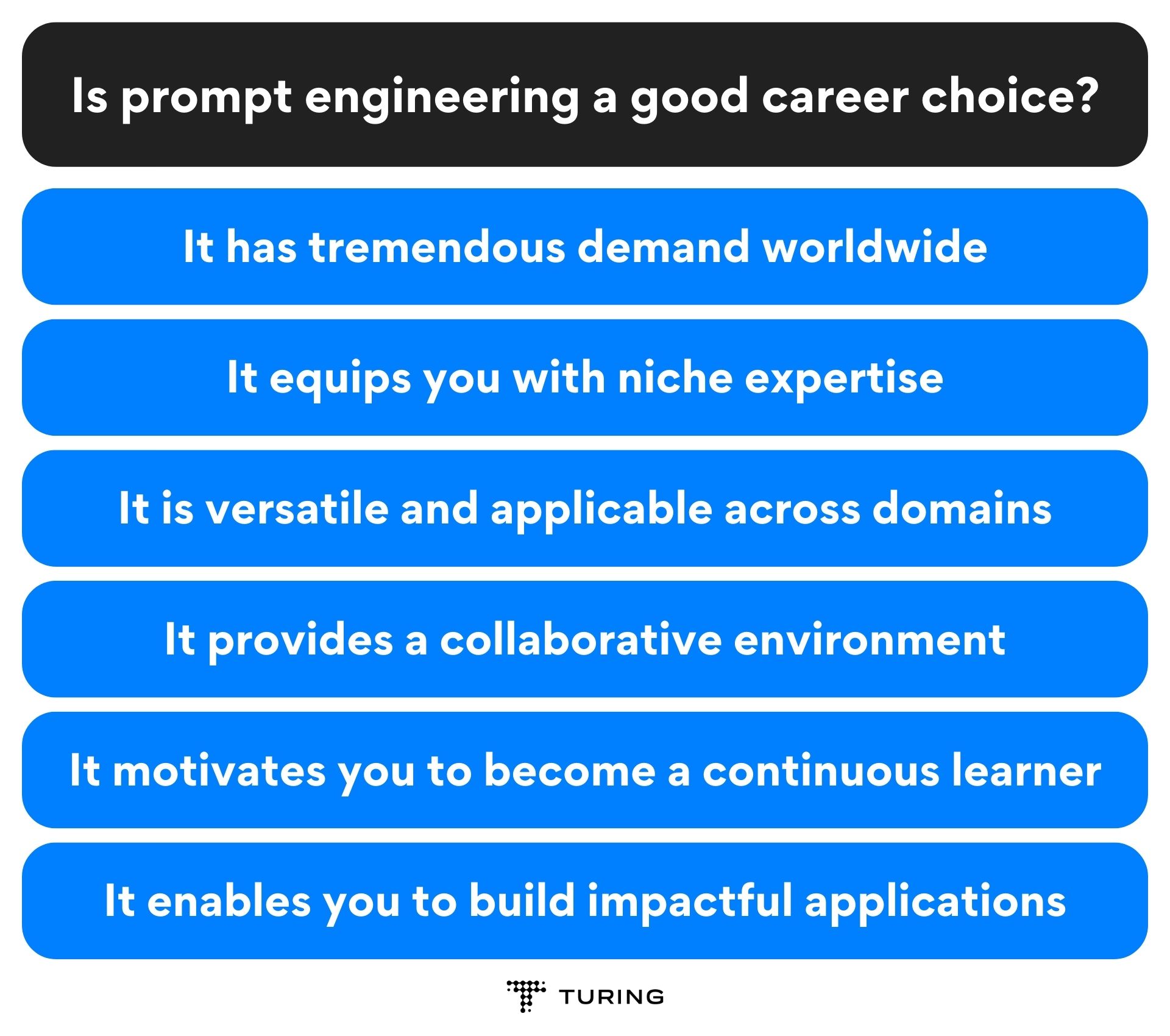
Is prompt engineering a good career choice?
Prompt engineering is a specialized field within the realm of AI and natural language processing that offers promising career prospects. As AI language models continue to advance, the demand for professionals skilled in prompt engineering is expected to grow. Here are a few reasons why prompt engineering can be a good career choice:
- It has tremendous demand worldwide: As AI language models advance, the demand for prompt engineering professionals is on the rise, creating exciting career prospects in the field.
- It equips you with niche expertise: With deep knowledge of AI language models, prompt engineers optimize outputs by designing effective prompts, making them sought-after professionals with specialized skills.
- It is versatile and applicable across domains: Prompt engineering finds application in diverse domains such as content generation, chatbots, and customer support systems, offering professionals the chance to work on a wide range of projects.
- It provides a collaborative environment: Working alongside data scientists, machine learning engineers, and domain experts, prompt engineers engage in interdisciplinary collaboration, fostering knowledge sharing and exposure to varied perspectives.
- It motivates you to become a continuous learner: Prompt engineering necessitates staying abreast of the latest advancements, techniques, and best practices in the rapidly evolving field of AI, providing ongoing opportunities for learning and skill development.
- It enables you to build impactful applications: By optimizing AI language models’ performance through effective prompt engineering, professionals contribute to real-world applications, witnessing the tangible impact of their work.
What skills do you need to become a prompt engineer?
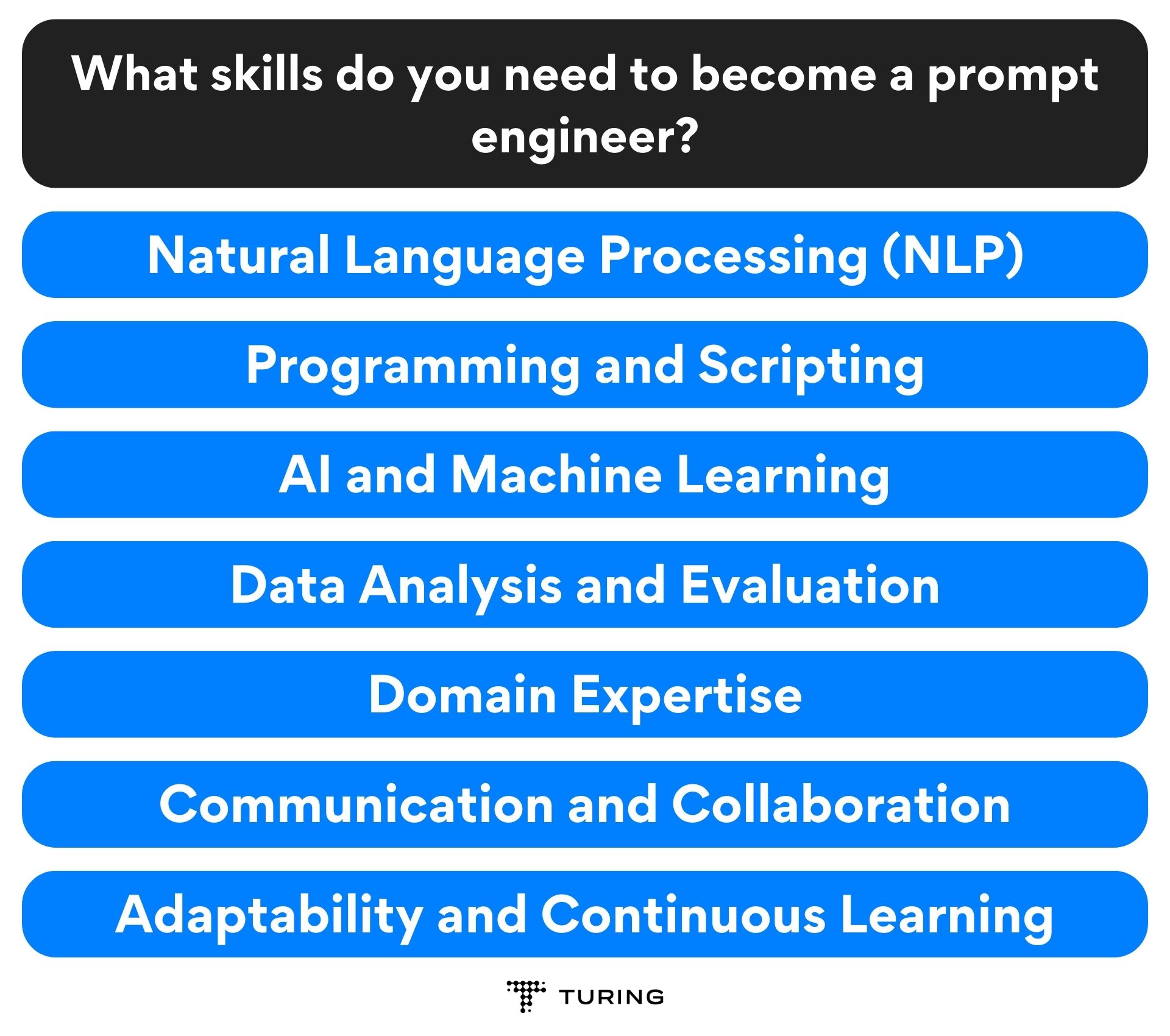
What skills do you need to become a prompt engineer?
Becoming a proficient prompt engineer requires a combination of technical skills, domain knowledge, and problem-solving abilities. Here are key skills that can contribute to success in prompt engineering:
- Natural Language Processing (NLP): A solid understanding of NLP concepts, including language modeling, text generation, and sentiment analysis, is essential. Proficiency in NLP techniques and algorithms enables effective prompt design and optimization.
- Programming and Scripting: Strong programming skills are vital for prompt engineering. Proficiency in languages such as Python allows prompt engineers to work with AI frameworks, preprocess data, and develop scripts for prompt generation and analysis.
- AI and Machine Learning: Knowledge of AI principles and machine learning algorithms is crucial. Understanding how AI language models, such as GPT-4, function, and their underlying architecture empowers prompt engineers to design effective prompts and fine-tune models if necessary.
- Data Analysis and Evaluation: Proficiency in data analysis techniques, including statistical analysis and evaluation metrics, helps assess the performance and quality of prompt-engineered outputs. The ability to interpret and draw insights from data aids in iterative prompt refinement.
- Domain Expertise: Familiarity with the specific domain in which prompt engineering is applied is advantageous. Having knowledge of industry-specific language conventions, technical jargon, or specific application requirements enables the design of prompts that align with domain-specific contexts.
- Creativity and Problem-Solving: Prompt engineering often requires creative thinking and problem-solving skills. Being able to devise innovative prompts, identify challenges, and find solutions to optimize model responses are valuable assets.
- Communication and Collaboration: Strong communication skills facilitate effective collaboration with data scientists, developers, and domain experts. Prompt engineers must effectively communicate prompt requirements, provide feedback, and work in interdisciplinary teams.
- Adaptability and Continuous Learning: Prompt engineering is a rapidly evolving field. Being adaptable to new technologies, techniques, and advancements in AI is crucial. A commitment to continuous learning and staying updated with the latest research and best practices is essential for professional growth.
Also, read: IT Hiring Trends 2022-23: 10 Most In-Demand Skills in US Companies
What are some best practices for prompt engineering?
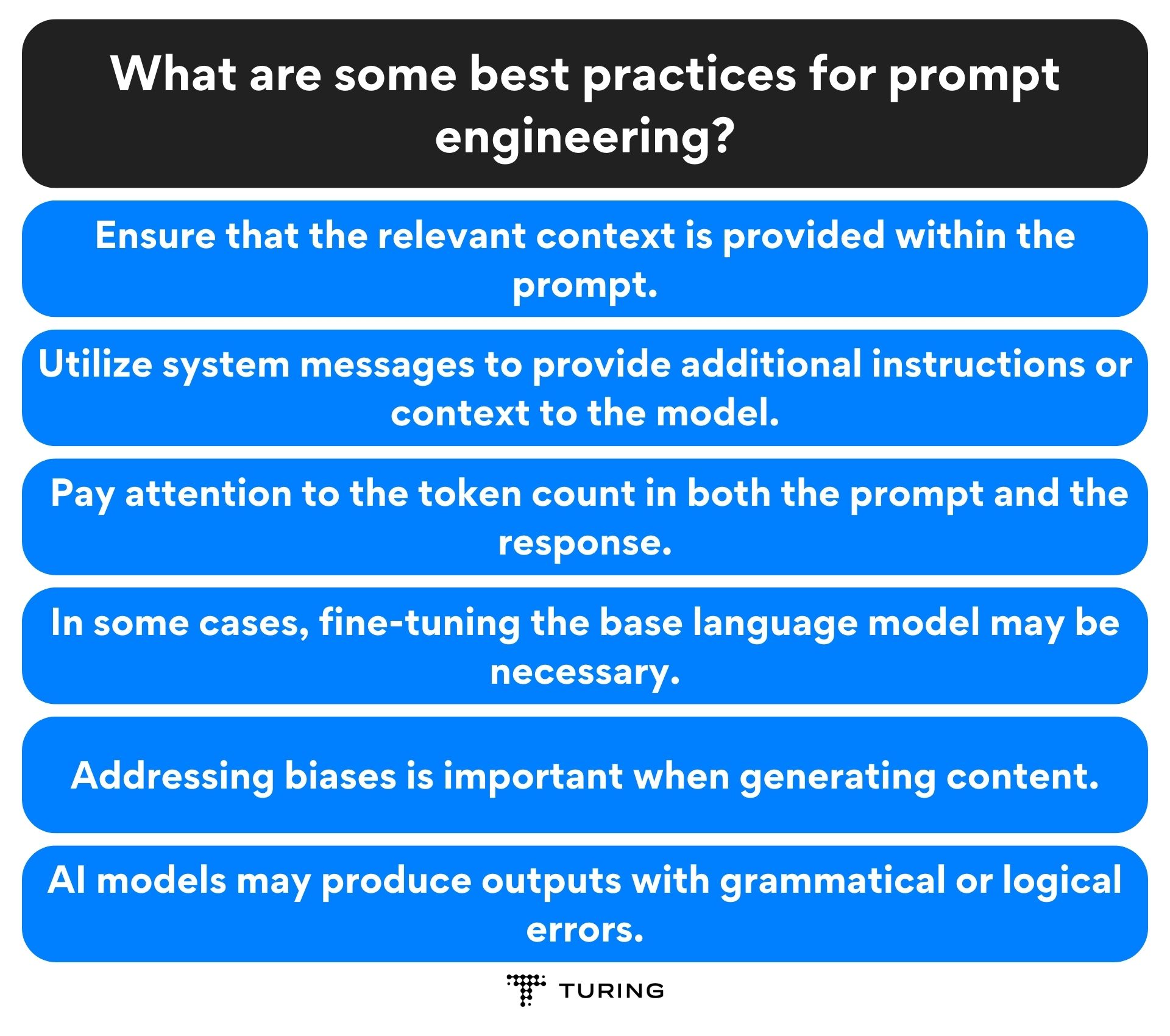
What are some best practices for prompt engineering?
Prompt engineering plays a crucial role in obtaining desired outputs from AI language models. You must follow some best practices to achieve the best results while using AI. Here are the best practices for prompt engineering.
- Context Window: Ensure that the relevant context is provided within the prompt. If the context is too long, the model may truncate or lose important information. Experiment with different context lengths to find the optimal balance.
- System Messages: Utilize system messages to provide additional instructions or context to the model. System messages are separate from user prompts and allow you to set the behavior or persona of the AI. Using explicit system messages can guide the model’s responses more effectively.
- Token Limit Considerations: Pay attention to the token count in both the prompt and the response. Language models have token limits, and longer prompts may result in truncated or incomplete responses. Keep track of the token count to ensure that the generated content remains within the model’s limits.
- Fine-Tuning: In some cases, fine-tuning the base language model may be necessary. Fine-tuning involves training the model on custom datasets or specific domains to improve its performance for specialized tasks. OpenAI provides guidance on the fine-tuning process to optimize model outputs.
- Bias Mitigation: Addressing biases is important when generating content. Evaluate the prompts and outputs for any unintended biases and make adjustments as necessary. OpenAI provides guidelines on handling bias and avoiding biased behavior in AI models.
- Error Handling and Post-Processing: AI models may produce outputs with grammatical or logical errors. Implement error handling and post-processing techniques to improve the quality of the generated content. This may involve grammar correction, removing irrelevant or incorrect information, or ensuring logical coherence.
Developers, don’t be weary of generative AI at all!
We’re saying it again! Generative AI and software development are meant to complement and not replace each other. You need to understand that AI can perform a certain set of functions. But this performance is still limited to the data that is made available to it. AI will require constant enhancements which will require human intervention, and even then, there will be some complex tasks that only humans can perform.
Let’s take an example of the calculator. When the calculator was invented, it didn’t replace expert mathematicians. In fact, it aided them to make more advancements in the field. In other words, it’s up to the user how to use technology.
You don’t have to fear AI, you have to use it for your own good. Keep improving your tech stack by adding skills that are required by the AI industry. There are plenty of AI-related opportunities waiting for you out there.
Are you a software developer looking for a remote AI job? Sign up on Turing today and work with top US companies. But that’s not all. Enjoy high salaries, flexible working hours, stellar career growth, and much more. Head over to the Apply for Jobs page now.
FAQs
- Is ChatGPT 4 better than 3?
While GPT-4 showcases enhanced contextual understanding, increased parameter count, specialization in domains, and improved quality control, it is expected to outperform GPT-3 by generating more coherent, accurate, and domain-specific responses, making it a more advanced language model. - Is ChatGPT 4 free to use?
Open AI’s ChatGPT 4 is not available to free users. You will have to subscribe to the ChatGPT Plus subscription in order to access GPT4. - Is Chat GPT-4 going to replace developers?
As said earlier, no version of AI can fully replace developers. AI, to be specific, Chat GPT4 is there to enhance the productivity of the developers and automate some of the basic programming. Other than that, AI will still require human interaction in order to write complex programming. - Will generative AI replace programmers?
No, generative AI is not here to replace programmers but to help them enhance their productivity. Generative AI can help automate basic programming codes that help developers to minimize their turnaround time. - What are the skills required to become a prompt engineer?
Key skills required to become a prompt engineer are expertise in Natural Language Processing (NLP), programming and scripting, data analysis and evaluation, domain expertise, creativity and problem-solving, communication and collaboration, and adaptability.
Join a network of the world's best developers and get long-term remote software jobs with better compensation and career growth.
